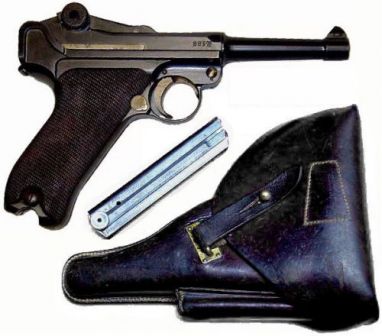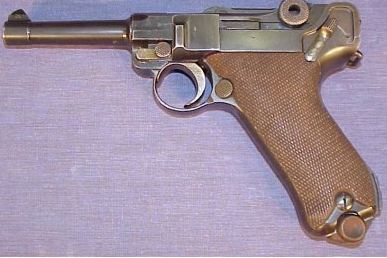P-08 - standart sidearm of German Military during WW I and WW II.
A view to proprietary Lugers' locking mechanism - the breechblock is at the rearmost position.
Commercial Parabellum in 7.65mm Luger/Para.
Commercial Parabellum carbine in 7.65mm Luger/Para with additional grip safety.
Characteristics
Type: Single Action
Chamber: 7.65mm Luger/Para, 9x19mm Luger/Para
Weight unloaded:
Length: 230 mm (with 102 mm barrel)
Barrel length: 98 mm, 102 mm, 152 mm, 203 mm and others
Capacity: 8 rounds
The Parabellum pistole was developed by Georg Luger in Germany, ca. in 1898. The Parabellum name comes from ancient Latin saying Si vis Pacem, Para bellum - if you want Peace, prepare for War. The Lugers' design is based on earlier Hugo Borchard idea, but Luger re-designed the Borchards' locking system into much smaller package. Most pre-WW II Parabellums were developed by DWM company in Germany, with some being manufactured under license in other countries. During WW II, many companies, such as Mauser werke and others, also produced Lugers.
The first country to adopt Lugers was Switzerland - they adopted the model 1900 Lugers, chambered in 7.65mm Luger/Para[bellum] round. In 1902 the DWM, along with Luger, by request of German Navy developed new round, 9x19mm Luger/Para[bellum], one of the most common pistol cartridges of the world, by re-necking the case of the 7.65mm Luger round. The Luger model 1904, in 9mm, was adopted by German Navy, following the German army (Reichswehr) in 1908. Since then, the Lugers were adopted by many countries and servred untill probably the 1950's or so.
All Parabellums are recoil-operated, locked breech, semi-automatic, striker fired handguns. All Lugers featured unique locking system, consisting of two tilting-up bars and short moving barrel. Some early Lugers featured automatic grip safety at the rear side of the grip. All lugers also featured frame-mounted manual safety at the left side of the gun. Lugers were manufactured with different barrel lenghts - standart german army Pistole 08 (Luger M1908) had 102 mm barrels; Navy models featured 152 mm (6 in) barrels, and Artillery models featured 203 mm (8 in) barrels. Commercial models were manufactured with barrels ranging from 98 mm up to 350 mm (14 in), some in 'carbine' versions, with additional forward handguard and detachable buttstock.
All lugers were very erconomical and accurate pistols, especially for the period those were developed in. However, all Lugers were too sensitive to fouling and for loose manufacturing tolerances, as well as too pricey, when compared to more modern designs, such as Browning High Popwer or Walther P38.


 13.19
13.19
 Jack The Ripper
Jack The Ripper





 Posted in:
Posted in:
0 komentar:
Posting Komentar